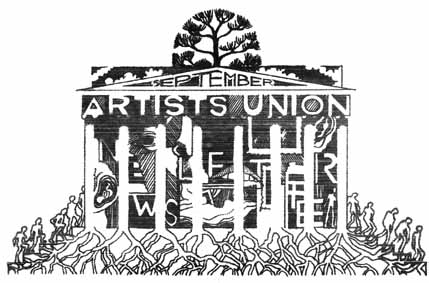 |
What was the Artists Union?Notes by Avis Saltsman - Page One |
Note: My text is on a white background and original AU documents & graphics are on a yellow ochre backround.

WHAT WAS THE ARTISTS’ UNION?
A Sunday afternoon: two parents, concerned that their children have a broad education, have taken them to a contemporary Art exhibition in a gallery. They enjoy the experience and the children may even have been inspired by the show, which has cost them nothing. The artist, meanwhile, will probably have had to pay for the use of the gallery, while the visitors may well think that the artist has been paid to show their work. For it is work and artists need to eat, be clothed and housed, and if they wish, bring up children, whilst still working as artists. The gallery director and staff are paid but who pays the artist?
However, whenever a conversation takes place about the proposition that artists should receive remuneration for the work they do, a member of the general public is likely to recall a world-famous artist who never received any in their lifetime and that is supposed to be the end of the argument. In fact, the struggling artist was an innovation of the twentieth century and, before that, various forms of state funding were available, aristocratic patronage being effectively, state funding. This has long since died out. So has the nineteenth-century market provided by its newly-affluent bourgeoisie. However, there was a tremendous expansion in art college provision in the nineteen-sixties and questions began to be asked by some of the people going through the process about their position in British society and their possible means of making a living.
Artists began to take measures to help themselves. In 1969 artists, some of whom worked from studios in the old St Katherine’s Dock before its development, named the ‘I’ Site, the first SPACE studios, established A.I.R. (Art Information Registry), an information service for the promotion of the arts from an office in Stepney Green. Its Registry constituted an artist’s index containing information on artist’s work, working techniques and material and of persons and organisations active in the arts. ‘CATALYST’, the first published registry and news sheet of activities from 1969 to 71 became AIRMAIL in 1972-3. The list was used by organisations all over Britain. The Registry offices were moved to Burlington House, home of the Arts Council, the organisation being funded by an Arts Council grant. Some of the same artists were involved in founding another self-help organisation in 1972, the Artists Union. (The Art Information Registry opened a gallery in October 1975 at 125/129 Shaftesbury Avenue but at the same time the Arts Council announced that the grant was not going to be increased).
TATE Archive has acquired most of the records of the national Artists Union which ran from 1972 until 1983. This was the initial working paper:-
THE ARTISTS UNION
After several meetings over a period of months, a commitment was made to the idea of an Artists Union affiliated to the TUC by a number of artists. The constitution of the Artists Union evolved from working party recommendations and at a subsequent meeting on Friday, May 19 a constitution was amended and ratified by artists which it is hoped will form the basis for a democratic structure capable of flexibility and which is completely responsive to the needs and demands of its members.
Full meetings of the Artists Union are held monthly at the union rooms, c/o Nash House, Carlton House Terrace, London, SW1 and the Artists Union welcomes and invites interested people and potential members to these meetings. The Artists Union bases its philosophy on positive commitment rather than passive acceptance.
The following workshops are at present meeting under the auspices of the Artists Union: Artists’ Role in Society; Media; Art. Patronage, Marketing and Money; Government Policy for the Arts; Policy within the Trades Union Movement, The Artist in Education; Art, Science, Technology and Industry; Women in Art; Exhibitions. Workshops provide a structure through which the membership of the Union focuses on particular areas of concern. These workshops at present constitute a mechanism for the investigation in depth of these areas together with the assessment and formulation of principles, aims and strategies on issues of vital importance to the Arts and their relationship to western civilisation.
The workshops also meet regularly in the Artists Union rooms c/o Nash House and these meetings are completely open to all and anyone; members and non-members may make proposals or suggestions to be put before the full membership at the monthly Branch Meetings with the possibility of this becoming official union policy.
Contact: Avis Saltsman (or Saltzmann), 17 Gerrard Road, Islington, London N1 8AY +44(0)20 7359 6294 or e-mail her
URL: http://www.art-science.com/Avis/au/au1.html
Last revised 14/10/2002 Copyright: Avis Saltsman 1998 - 2002